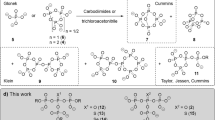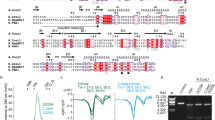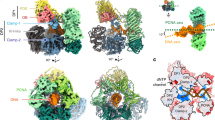Abstract
THE mechanism of action of pancreatic deoxyribonuclease, now available in the crystalline state1,2, on highly polymerized deoxypentose nucleic acids is still obscure. The enzymatic attack is known to result in the formation of dialysable oligonucleotides and of a non-dialysable ‘core’ which, in the case of the nucleic acids from calf thymus3,4 and wheat germ5, is characterized by proportions of adenine, and to a lesser degree of thymine, greatly in excess of those encountered in the original substrate. Mononucleotides and inorganic phosphate are not found among the degradation products3,4, and this precludes the attribution to deoxyribonuclease of functions similar to those of phosphomonoesterases. It could be regarded as a phosphodiesterase of a closely circumscribed, as yet undefinable, specificity. A small number of acidic groups is, in fact, Liberated during the digestion6. That the attack of an enzyme the action of which consists in the depolymerization of a substance of high molecular weight, exhibiting no easily recognizable periodicity of constituent sequence, must follow an intricate pattern is clear: every break of the original molecule produces substrates that are new and different; the enzyme must deal with kaleidoscopic substrate changes.
This is a preview of subscription content, access via your institution
Access options
Subscribe to this journal
Receive 51 print issues and online access
$199.00 per year
only $3.90 per issue
Buy this article
- Purchase on Springer Link
- Instant access to full article PDF
Prices may be subject to local taxes which are calculated during checkout
Similar content being viewed by others
References
Kunitz, M., Science, 108, 19 (1948).
Kunitz, M., J. Gen. Physiol., 33, 349, 363 (1950).
Zamenhof, S., and Chargaff, E., J. Biol. Chem., 178, 531 (1949).
Zamenhof, S., and Chargaff, E., J. Biol. Chem., 187, 1 (1950).
Brawerman, G., and Chargaff, E., J. Amer. Chem. Soc., 73, 4052 (1951).
Carter, C. E., and Greenstein, J. P., J. Nat. Cancer Inst., 7, 29 (1946).
Zamenhof, S., and Chargaff, E., J. Biol. Chem., 186, 207 (1950).
Tamm, C., Hodes, M. E., and Chargaff, E., J. Biol. Chem. (in the press).
Magasanik, B., and Chargaff, E., Biochim. et Biophys. Acta, 7, 396 (1951).
Fischer, F. G., Böttger, I., and Lehmann-Echternacht, H., Z. physiol. Chem., 271, 246 (1941).
McCarty, M., J. Gen. Physiol., 29, 123 (1946).
Weissman, N., and Fisher, J., J. Biol. Chem., 178, 1007 (1949).
Jungner, G., Science, 113, 378 (1951).
Author information
Authors and Affiliations
Rights and permissions
About this article
Cite this article
TAMM, C., CHARGAFF, E. Specific Requirements for the Action of Deoxyribonuclease. Nature 168, 916–917 (1951). https://doi.org/10.1038/168916a0
Issue Date:
DOI: https://doi.org/10.1038/168916a0
Comments
By submitting a comment you agree to abide by our Terms and Community Guidelines. If you find something abusive or that does not comply with our terms or guidelines please flag it as inappropriate.



